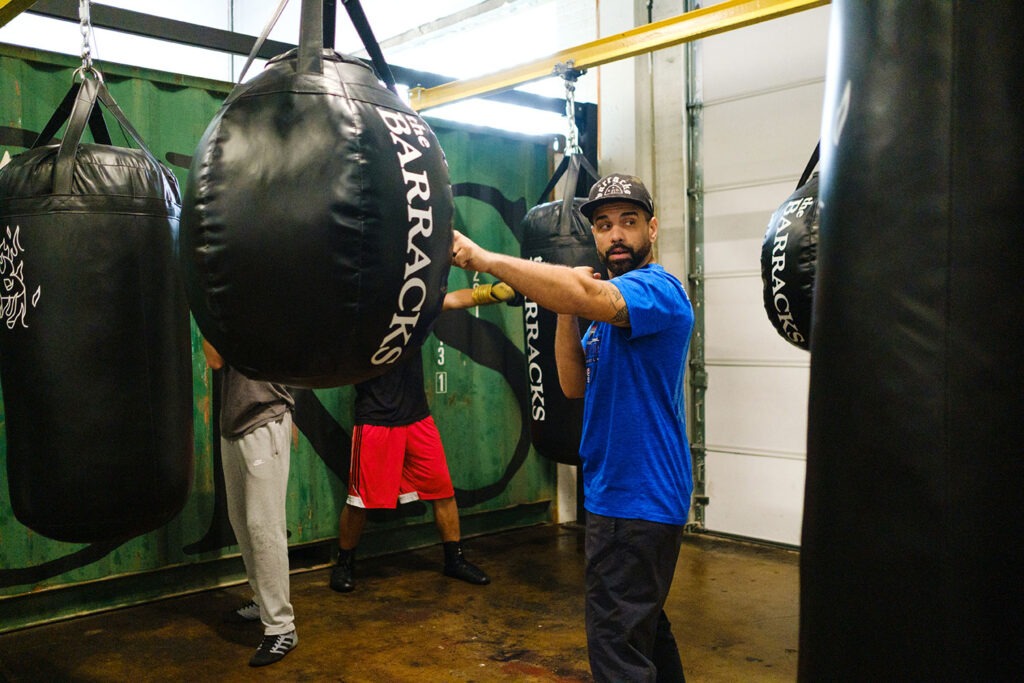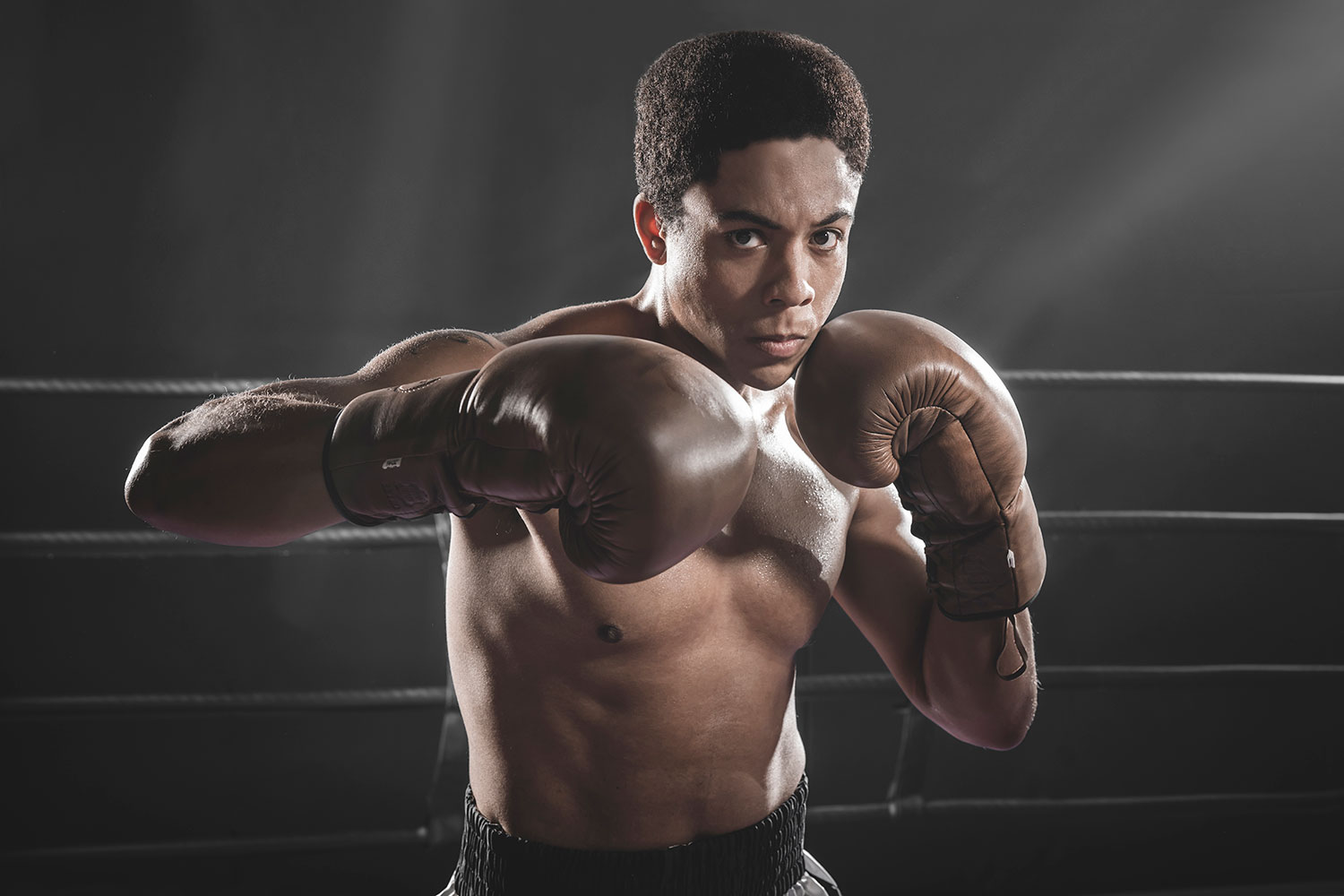Opera, jazz, and boxing are three topics that most people would never expect in the same realm. At the center of this oddball Venn diagram sits Champion, playing January 27 through February 11 at Chicago’s Lyric Opera. To make this bold contemporary opera succeed, the producers tapped David Ortiz Jr., co-owner of The Barracks, a boxing club in Hermosa, to serve as the fight consultant.
Jazz musician and composer Terence Blanchard’s first opera, Champion tells the true story of welterweight king Emile Griffith, a highly successful boxer who hid his sexuality from most of the world, only to become forever haunted by his very public response to an anti-gay slur: In 1962, during the weigh-in to their upcoming fight, another boxer used a homophobic phrase in reference to Griffith. And later that night, the enraged Griffith pummeled his opponent into a coma; the man died 10 days later.
Training the Lyric cast on how to move and act like boxers is just another feather in the cap for Ortiz, an entrepreneur who previously launched a streetwear company. A native to the city’s Northwest Side who now lives in Forest Park, 39-year-old Ortiz coached his oldest son Jeremy, now 20, into becoming one of the best boxers in the country, including Silver and Golden Gloves titles. After making it to the quarter-finals in the 2022 U.S. Championships for the Olympic trials, Jeremy went pro last year — and he’s also joining his dad as assistant consultant to the Lyric actors.
David Ortiz spoke with Chicago magazine about boxing, opera, and the weight of societal expectations.
Tell me about your history with boxing. It runs in the family, yes?
Yeah. I’m of Puerto Rican descent. Boxing is one of those sports that, just being Puerto Rican — whether you’re in Chicago, Philly, New York, Florida — it’s just one of those sports you grow up with. You grow up with a bat and a glove, and then a pair of boxing gloves. It’s in the bloodline. In the ’60s, my father boxed in Clarendon Park. It was just one of those things to get the kids off the streets.
Eventually, my father taught me how to box; we had a heavy bag in the basement. But I was a wrestler growing up. The sport has come such a long way from how my father understood it, how Emile went through it. I brought it back into the family when I started training my son Jeremy. He was around 10 years old when he got into boxing.
Did Jeremy’s involvement in boxing put you on the path to opening The Barracks?
Absolutely. He was starting to evolve in the sport, and I wanted a way to spend more time with him and also build around him.

Have you ever been to the opera?
I have been to the opera, as a child. It was a field trip. Might’ve been Lyric Opera? It was a long time ago.
Yep, I did the same thing: In fourth or fifth grade, we went on a field trip to see Elixir of Love at the Lyric.
Until now, I’ve never been back to the opera. But I remember the aesthetic — it looked way different than anything I’d ever been exposed to. I thought it was pretty cool, but I didn’t understand what was going on.
Were you surprised to discover there’s such a thing as a “jazz opera”?
No. I’m really really big on music, all types of music. Cross-pollination is everything, man. Art is art.
How did you become Lyric’s fight consultant on The Champion?
They were looking for a facility for doing a photo shoot, something that could make you think of gyms in the ’60s. My [Barracks] partner is an artist and a graphic designer, and we kept the walls very plain with exposed brick, so it’s got a throwback feel. They loved the layout.
The day of the photo shoot, Justin Austin, the actor, had some questions. My son Jeremy was able to provide some guidance, and they were really impressed by Jeremy’s ability to speak to them. So we had another meeting with the Lyric team, and they had a lot of great questions about boxing and about how to be a great coach. Ultimately, they felt confident that we were the right team. I’m the lead on the project, and my team is Jeremy Ortiz and Perla Vargas.
What are the rehearsals like?
I’m having fun with it, man. It’s good to unplug from the actual sport and plug into the theatrics of it. It’s my first time working a bunch of actors, singers, and dancers. They’re engaging. We guide them on the fluidness of boxing — how to enter the ring, how to stand and position your hands, how to walk toward your opponent, how to throw a punch. It’s good for all of us, you know, because part of the challenge with boxers and trainers is they get pigeonholed into one thing. These kinds of opportunities are few and far between.
Prior to Champion, tell me what you knew about Emile Griffith. Is his name still known in the 21st-century boxing world?
One thing we deal with all the time in our sport, which some people might not fully understand, is controlled violence. But when you lose control, just like in football, dangerous things can happen. So we get stories with stigma — like what Emile faced, killing somebody. When the Lyric brought it to me, I was very familiar with the fight. We’ve read about this, we’ve discussed it. It’s common to know the story.
So Emile is known as the boxer who killed someone in the ring. Is he also known as the gay boxer?
No. His life after boxing, I was not that familiar with. The sport is extremely masculine in its history. Back then, other lifestyles were way more disguised.
We obviously live in a much different era now, but as you say, boxing still has a very macho reputation. How do today’s boxing gyms treat queer people?
The sport itself has evolved. I have a number of members from the LGBTQ community, including participants from the violence prevention and intervention program, and I don’t train them any differently. I cornered one of my members for a fight. She’s a Chicago police officer, and at the time, she was engaged to my niece.
Whether you’re a beginner boxer or an expert, nothing matters when you walk in the door: not your sexuality, not your creed, your race, your religion. Inside that space, none of that matters. Everyone gets the same respect. I encourage that with all of my members. I have women members, I have gay members, I have children, I have adults. I have one woman who has cerebral palsy; we make sure she’s included and she feels a part of the sport. I can’t tell you what it was like in a boxing club when I was 15, 16. I don’t know what they would’ve said. But today, it’s a lot more inclusive. Boxing gets a stigma for lives lost, but not enough credit for the lives it’s saved.



